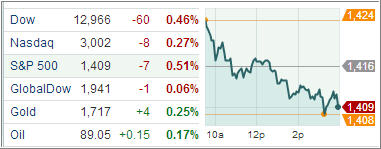US equities finished lower as politicians in Washington restarted the rhetoric on how to manage the nation’s fiscal policy, and a measure of factory output showed unexpected contraction in November.
The Institute for Supply Management’s index of manufacturing activity dropped to 49.5 in November from 51.7 a month earlier, signaling contraction for the first time since July 2009. Economists polled by Bloomberg had expected a reading of 51.4 and attributed the decline to concerns about the so-called fiscal cliff rather than disruptions due to Superstorm Sandy. The fiscal concerns are affecting business decision making as companies put spending and hiring decisions on hold
US equity indexes have signaled cautious optimism over the past two weeks and with less than 29 days left to the edge of the fiscal cliff before billions of dollars in automatic spending cuts and tax hikes come into effect, house Republican leaders unveiled a counter offer to break the negotiations stalemate. According to House Speaker John Boehner, the new proposal takes a middle ground approach and counts $800 billion in new revenue through tax reforms.
Separately, a Commerce Department report showed construction activity jumped 1.4 percent in October, well above expectations of a 0.5 percent gain.
Also, Markit’s US purchasing manager’s index reading for November jumped to a six-month high of 52.8, while China, the world’s second largest economy, showed signs of improvement. Its purchasing managers’ index climbed to a seven month high of 50.6 in November while separate readings released by HSBC Plc and Markit Economics supported government claims.
The Dow Jones Industrial Average (DJIA) retreated 60 points while the S&P 500 Index (SPX) shed 7 points with industrials and materials fronting the slide and technology and telecommunications pacing the gains among its 10 business sectors.
Treasuries logged mixed performance on Monday after data indicated manufacturing activity in the US fell to its lowest level since July 2009, hit by reduced hiring plans and a drop in new orders. The benchmark 10-year Treasury yield rose one basis point to 1.63 percent while yield on the 30-year Treasury bond fell one basis point to 2.80 percent.
The US dollar weakened Monday after strong Chinese manufacturing survey and optimism over Greece undermined its safe haven appeal. The economic block’s common currency gained after Greece announced plans to buy back bonds in an effort to cut its debt load.
Also, German Chancellor Angela Merkel’s statement over the weekend that Berlin may consider a debt write off for Greece in future, if the country returned to budget surplus, helped boost confidence.
European stocks meanwhile pared early gains in the afternoon session after US ISM manufacturing index showed signs of weakness in November.
The Stoxx Europe 600 index finished a paltry 0.13 percent higher after gaining more than 0.3 percent ahead of the US data.
The DAX 30 index climbed 0.7 percent in Frankfurt while the French CAC 40 index added 0.4 percent in Paris.
The FTSE 100 index rose less than one percent after a rally in mining stocks was offset by banking shares.
Our Trend Tracking Indexes (TTIs) retreated slightly but held their bullish grip with the Domestic TTI now showing +1.90% and the International TTI hanging on at a stronger +4.65%.
Cliff talks will continue to control market direction until some breakthrough has been made, or, in the case of no agreement, which looks increasingly likely, the bears will have a field day, and our TTIs can head the other way in a hurry.
For quick access to the most recent StatSheet including TTI charts and all momentum figures, click here. You can read the latest ETF Model Portfolio update here.
Contact Ulli
